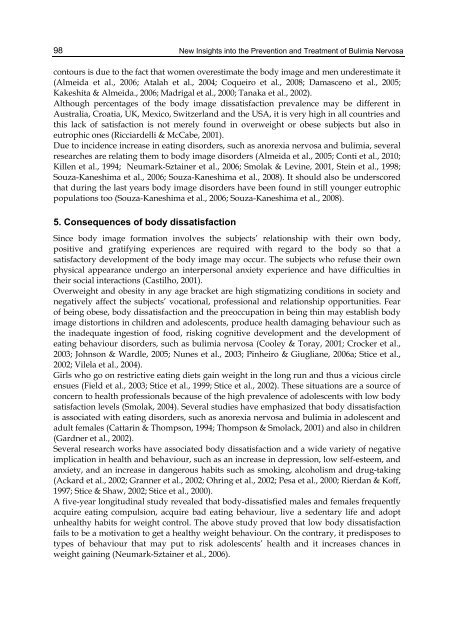new insights into the prevention and treatment of bulimia nervosa
new insights into the prevention and treatment of bulimia nervosa
new insights into the prevention and treatment of bulimia nervosa
You also want an ePaper? Increase the reach of your titles
YUMPU automatically turns print PDFs into web optimized ePapers that Google loves.
98<br />
New Insights <strong>into</strong> <strong>the</strong> Prevention <strong>and</strong> Treatment <strong>of</strong> Bulimia Nervosa<br />
contours is due to <strong>the</strong> fact that women overestimate <strong>the</strong> body image <strong>and</strong> men underestimate it<br />
(Almeida et al., 2006; Atalah et al., 2004; Coqueiro et al., 2008; Damasceno et al., 2005;<br />
Kakeshita & Almeida., 2006; Madrigal et al., 2000; Tanaka et al., 2002).<br />
Although percentages <strong>of</strong> <strong>the</strong> body image dissatisfaction prevalence may be different in<br />
Australia, Croatia, UK, Mexico, Switzerl<strong>and</strong> <strong>and</strong> <strong>the</strong> USA, it is very high in all countries <strong>and</strong><br />
this lack <strong>of</strong> satisfaction is not merely found in overweight or obese subjects but also in<br />
eutrophic ones (Ricciardelli & McCabe, 2001).<br />
Due to incidence increase in eating disorders, such as anorexia <strong>nervosa</strong> <strong>and</strong> <strong>bulimia</strong>, several<br />
researches are relating <strong>the</strong>m to body image disorders (Almeida et al., 2005; Conti et al., 2010;<br />
Killen et al., 1994; Neumark-Sztainer et al., 2006; Smolak & Levine, 2001, Stein et al., 1998;<br />
Souza-Kaneshima et al., 2006; Souza-Kaneshima et al., 2008). It should also be underscored<br />
that during <strong>the</strong> last years body image disorders have been found in still younger eutrophic<br />
populations too (Souza-Kaneshima et al., 2006; Souza-Kaneshima et al., 2008).<br />
5. Consequences <strong>of</strong> body dissatisfaction<br />
Since body image formation involves <strong>the</strong> subjects’ relationship with <strong>the</strong>ir own body,<br />
positive <strong>and</strong> gratifying experiences are required with regard to <strong>the</strong> body so that a<br />
satisfactory development <strong>of</strong> <strong>the</strong> body image may occur. The subjects who refuse <strong>the</strong>ir own<br />
physical appearance undergo an interpersonal anxiety experience <strong>and</strong> have difficulties in<br />
<strong>the</strong>ir social interactions (Castilho, 2001).<br />
Overweight <strong>and</strong> obesity in any age bracket are high stigmatizing conditions in society <strong>and</strong><br />
negatively affect <strong>the</strong> subjects’ vocational, pr<strong>of</strong>essional <strong>and</strong> relationship opportunities. Fear<br />
<strong>of</strong> being obese, body dissatisfaction <strong>and</strong> <strong>the</strong> preoccupation in being thin may establish body<br />
image distortions in children <strong>and</strong> adolescents, produce health damaging behaviour such as<br />
<strong>the</strong> inadequate ingestion <strong>of</strong> food, risking cognitive development <strong>and</strong> <strong>the</strong> development <strong>of</strong><br />
eating behaviour disorders, such as <strong>bulimia</strong> <strong>nervosa</strong> (Cooley & Toray, 2001; Crocker et al.,<br />
2003; Johnson & Wardle, 2005; Nunes et al., 2003; Pinheiro & Giugliane, 2006a; Stice et al.,<br />
2002; Vilela et al., 2004).<br />
Girls who go on restrictive eating diets gain weight in <strong>the</strong> long run <strong>and</strong> thus a vicious circle<br />
ensues (Field et al., 2003; Stice et al., 1999; Stice et al., 2002). These situations are a source <strong>of</strong><br />
concern to health pr<strong>of</strong>essionals because <strong>of</strong> <strong>the</strong> high prevalence <strong>of</strong> adolescents with low body<br />
satisfaction levels (Smolak, 2004). Several studies have emphasized that body dissatisfaction<br />
is associated with eating disorders, such as anorexia <strong>nervosa</strong> <strong>and</strong> <strong>bulimia</strong> in adolescent <strong>and</strong><br />
adult females (Cattarin & Thompson, 1994; Thompson & Smolack, 2001) <strong>and</strong> also in children<br />
(Gardner et al., 2002).<br />
Several research works have associated body dissatisfaction <strong>and</strong> a wide variety <strong>of</strong> negative<br />
implication in health <strong>and</strong> behaviour, such as an increase in depression, low self-esteem, <strong>and</strong><br />
anxiety, <strong>and</strong> an increase in dangerous habits such as smoking, alcoholism <strong>and</strong> drug-taking<br />
(Ackard et al., 2002; Granner et al., 2002; Ohring et al., 2002; Pesa et al., 2000; Rierdan & K<strong>of</strong>f,<br />
1997; Stice & Shaw, 2002; Stice et al., 2000).<br />
A five-year longitudinal study revealed that body-dissatisfied males <strong>and</strong> females frequently<br />
acquire eating compulsion, acquire bad eating behaviour, live a sedentary life <strong>and</strong> adopt<br />
unhealthy habits for weight control. The above study proved that low body dissatisfaction<br />
fails to be a motivation to get a healthy weight behaviour. On <strong>the</strong> contrary, it predisposes to<br />
types <strong>of</strong> behaviour that may put to risk adolescents’ health <strong>and</strong> it increases chances in<br />
weight gaining (Neumark-Sztainer et al., 2006).














![focuspdca.ppt [Compatibility Mode]](https://img.yumpu.com/22859457/1/190x146/focuspdcappt-compatibility-mode.jpg?quality=85)


